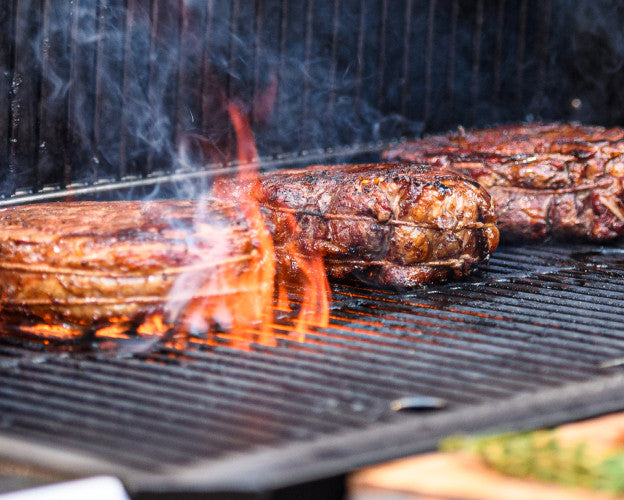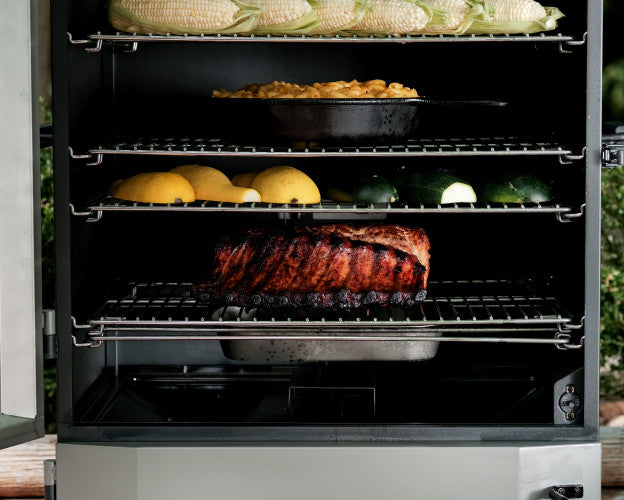Smoking for 5+ hours can seem like a daunting task, but the flavors you can produce are something to admire. If you are just learning smoking or perfecting your craft, this is the article for you.
Is smoking for over 5 hours' worth it?
The slow cooking process and infusion of smoke can create a rich and distinctive taste, especially for certain types of meat like brisket, ribs, and pulled pork. Smoked meats often have a tender, melt-in-your-mouth quality due to the extended cooking time.
If you enjoy fall of the bone ribs, or pulled pork with juicy, tender meat, smoking for over 5 hours is worth it.
Basic Smoking Concept
To achieve smoked meat, the general concept is to produce indirect heat in your grill from 225-245 degrees. This process allows your meat to tenderize and breaks down the collagen. This breakdown makes the meat easier to chew and more palatable. Add in wood chunks, pellets, or charcoal and you can get a whole new flavor profile to go along with this.
Should I buy a smoker for this?
You can turn your basic grill into a smoker, but if you want to perfect smoking, we recommend getting a smoker. You can get a grill that is designed for smoking, such as the Gravity Series® Grills or you can get vertical smokers designed only for smoking.
What can you smoke?
Typically, you find success in smoking fattier cuts of meat with tougher connective tissues. Some meats this includes are brisket, pork butt/shoulder, ribs, chicken, turkey, pork ribs, and sausage. You can expand this with smoked dips, cheeses, nuts, fruits, vegetables, seafood, and more!


Tools & Equipment Checklist
Before you dive into a long smoking session, make sure you’ve got the essentials.
- Masterbuilt Gravity Series® Grill and Smoker or Vertical Smokers
- Digital meat thermometer
- Water pan to help regulate humidity
- Spray bottle filled with apple juice, vinegar, or broth for spritzing
- Butcher paper or foil for wrapping during the stall phase
How should you pair smoke?

- Oak - Oak wood imparts a medium, smoky flavor that is stronger than most fruit woods but lighter than hickory or mesquite. Best blended with apple, cherry, or hickory woods, but works well by itself with just about any meat.
- Hickory - Hickory wood delivers a sweet yet strong flavor, comparable to the flavor of bacon. The smoke can be quite pungent, but it does add a nice, strong flavor to just about anything. Most popular with pork and ribs.
- Mesquite - Mesquite wood is perhaps most synonymous with Texas BBQ. This smoking wood burns hot and quick, producing a lot of savory, earthy smoke. Best used for steak or brisket.
- Maple - Maple wood has a mild, slightly sweet flavor. Works well with poultry, vegetables, and cheeses.
- Pecan - Pecan wood burns quick and produces a mild, sweet flavor. Works best with fish, chicken, or ribs.
- Apple - A fruit wood. Has a mild, subtle, sweet, fruity flavor. Ideal for poultry, beef, ham, lamb and fish.
For more in-depth information, see how to choose the right smoking wood.
Flavor Layering Tips
Enhance your smoke session with these quick strategies:
-
Dry rubs: Apply at least 30–60 minutes before cooking to build bark.
-
Marinades: Use overnight for deeper flavor, especially for poultry and pork.
-
Spritzing: Use a mix of water and apple cider vinegar every hour after the first two hours to attract smoke and keep meat moist.
-
Resting: Wrap meat and let it rest at least 30 minutes after smoking to lock in juices and finish carryover cooking.
How to Smoke
- Choose the meat or ingredients you want to smoke. Make sure the products you choose will benefit from longer smoking times.
- Prepare the Meat or Ingredients: Trim excess fat, apply dry rubs or marinades, and let the meat come to room temperature before placing it in the smoker. This helps the flavors penetrate the meat more effectively. We have many recipes on our website for brines, seasonings, marinades, go check it out yourself or search online. The best part about BBQ is searching for the perfect way to smoke.
- Preheat and Set Up the Smoker: Preheat your smoker to the desired temperature. For most long smoking sessions, a temperature range of 225°F to 245°F is common.
- Maintain Temperature and Smoke Levels: Keep a close eye on the smoker's temperature and ensure a consistent level of smoke throughout the cooking process. You may need to add charcoal or wood as needed to maintain the temperature. Keep the smoke flowing during this time to ensure a robust smoky flavor. After about 4 hours, the food's surface may become less receptive to smoke, and additional smoking may have a limited impact on flavor.
- Use a Water Pan: Placing a water pan in the smoker can help regulate the temperature, add moisture to the cooking environment, and prevent the meat from drying out during the extended cooking time.
- Limit Opening the Smoker: Each time you open the smoker, you release heat and smoke, which can extend the cooking time. Aim to minimize openings and use a meat thermometer with a remote probe to monitor the internal temperature without opening the smoker. A good rule is, "if you are looking, it isn't cooking."
- Wrap in Foil or Butcher Paper (Optional): After a few hours of smoking and once the meat has developed a good amount of smoke flavor, you might consider wrapping the meat in foil or butcher paper. This helps accelerate the cooking process and retains moisture.
- Be Patient: Extended smoking sessions require patience. The low and slow cooking method allows the meat to tenderize gradually, avoiding rushing the process.
- Spritzing or Basting (Optional): Some pitmasters choose to spritz or baste the meat with liquids like apple juice, vinegar, or a marinade. This can help keep the surface moist and add extra flavor.
- Monitor Internal Temperature: Use a meat thermometer to monitor the internal temperature of the meat. Different meats have specific target temperatures for doneness. For example, pork shoulder and brisket are often smoked until they reach an internal temperature of around 200°F (93°C) for optimal tenderness.
- As the smoked food approaches its target internal temperature, remember that it will continue to cook even after you remove it from the smoker. This phenomenon is known as carryover cooking. To prevent overcooking, aim to remove the food from the smoker when it is a few degrees below the desired final internal temperature. The residual heat will continue to raise the temperature during the resting period.
- Resting Period: Once the meat reaches the desired internal temperature, remove it from the smoker and let it rest for a period, usually around 30 minutes. This allows the juices to redistribute throughout the meat, resulting in a more flavorful and juicier final product.
Recommended recipes
Try this culinary masterpiece that blends the rich, smoky essence of slow-cooked ribs with the delightful tang of pomegranate-infused barbecue glaze. Smoked Pomegranate BBQ Ribs
The slow smoking process works its magic, rendering the meat juicy and preserving its natural moisture. Have the perfect balance of smokiness, tenderness, and richness! Smoked Turkey Breast Recipe
Indulge in sandwiches, chili, tacos & more with the classic, and smoky Pulled Pork!
FAQ
Q: Can I smoke fish for 5+ hours?
A: Not recommended—most fish are done in 1–2 hours. Go for cold-smoking techniques if you want longer exposure.
Q: What do I do if my temperature spikes or drops?
A: Check the hopper and fan intake for blockages. Open the hopper lid briefly to stabilize the charcoal burn, then reclose and monitor.
Q: Should I wrap my meat?
A: Wrap when internal temps stall (usually around 160°F). Use butcher paper for better bark, foil for faster cooks.
Remember that smoking is a skill that improves with experience. Be prepared to adjust your approach based on factors like your specific smoker, weather conditions, and the type of meat you are smoking. Experimentation and practice will help you master the art of smoking food for extended periods.














